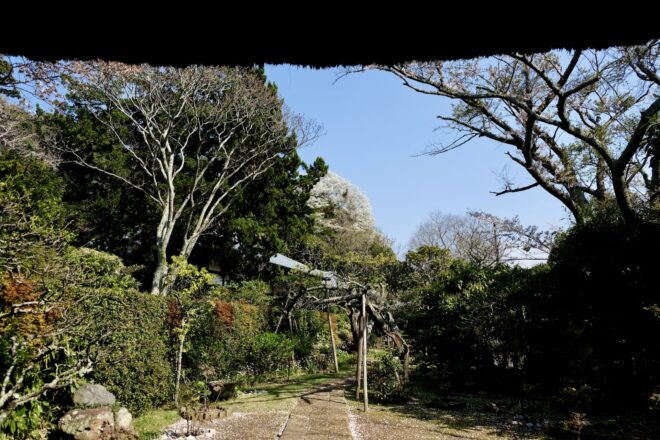The area of northwest Kamakura close to present-day Kita-Kamakura Station is the location of numerous important Rinzai Zen temples.
One of these is Engaku-ji, which is the second ranked temple among Kamakura’s Gozan, or “Five Mountains” temples. (In order, Kencho-ji, Engaku-ji, Jufuku-ji, Jochi-ji, Jomyo-ji.)
This is the entrance to Daihonzan Engaku-ji (Head Temple Engaku-ji) off the old Kamakura Kaido road.

ALL PHOTOS THE JAPAN JOURNAL
Looking left, Kita-Kamakura Station is just visible over the pond behind the cherry blossoms. The pond is called the White Egret Pond. According to temple legend, when the temple founder departed China he was led to this spot by a white egret, which landed on the water.

ALL PHOTOS THE JAPAN JOURNAL
Much of the pond was reclaimed and the surrounding forest cut down in 1889 to allow for the construction of one of Japan’s first railways, the Yokosuka Line.

ALL PHOTOS THE JAPAN JOURNAL
Most visitors thus begin their Engaku-ji journey here, on the new path that runs parallel to the tracks. at the foot of the steps to the Somon gate.

ALL PHOTOS THE JAPAN JOURNAL
Beyond the Somon, the mighty Sanmon.

ALL PHOTOS THE JAPAN JOURNAL
And from the shadow of the Sanmon, the Butsuden. The main hall, like many other buildings on the temple grounds, has been destroyed in catastrophes and studiously rebuilt numerous times since the temple was founded in 1282. The present Butsuden was completed as recently as 1964.

ALL PHOTOS THE JAPAN JOURNAL
The main image of Shaka Nyorai is original only above the shoulders. The white dragon on the ceiling was painted at the time of the reconstruction by Moriya Tadashi (1912-2003) under the watchful eye of Maeda Seison (1885-1977), who lived very close to Engaku-ji for decades and understood the job at hand.

ALL PHOTOS THE JAPAN JOURNAL
A monk on his way in, cherry blossoms on their way out (April 1, 2023).

ALL PHOTOS THE JAPAN JOURNAL
Gateway to Kojirin, a Zen meditation space for lay people. Visit the temple’s website for details.

ALL PHOTOS THE JAPAN JOURNAL

ALL PHOTOS THE JAPAN JOURNAL
The temple complex is laid out either side of this long central path.

ALL PHOTOS THE JAPAN JOURNAL

ALL PHOTOS THE JAPAN JOURNAL

ALL PHOTOS THE JAPAN JOURNAL

ALL PHOTOS THE JAPAN JOURNAL
Yamabuki (Japanese kerria) (April 1, 2023)

ALL PHOTOS THE JAPAN JOURNAL

ALL PHOTOS THE JAPAN JOURNAL

ALL PHOTOS THE JAPAN JOURNAL
Lizard and lichen

ALL PHOTOS THE JAPAN JOURNAL
Rock tobacco, paper plant and cherry blossoms

ALL PHOTOS THE JAPAN JOURNAL
The temple bell at the top of the hill, cast in 1301, is a National Treasure.

ALL PHOTOS THE JAPAN JOURNAL
The view from the top with the benefit of zoom. In the center is Tokei-ji, a former convent, sanctuary for women and the burial place of many artists and literati, including the aforementioned doyen of Japanese-style painting Maeda Seison and Zen luminary Suzuki Daisetz.

ALL PHOTOS THE JAPAN JOURNAL
The entrance to Kigen-in. Natsume Soseki (1867-1916) lodged here for a couple of weeks in 1894 along with a similarly young Suzuki. I Am Not a Cat so can only peer through The Gate.

ALL PHOTOS THE JAPAN JOURNAL
The kyudo (archery) dojo (training hall) just inside the entrance to Engaku-ji.

ALL PHOTOS THE JAPAN JOURNAL
The way out is the way in.

ALL PHOTOS THE JAPAN JOURNAL








